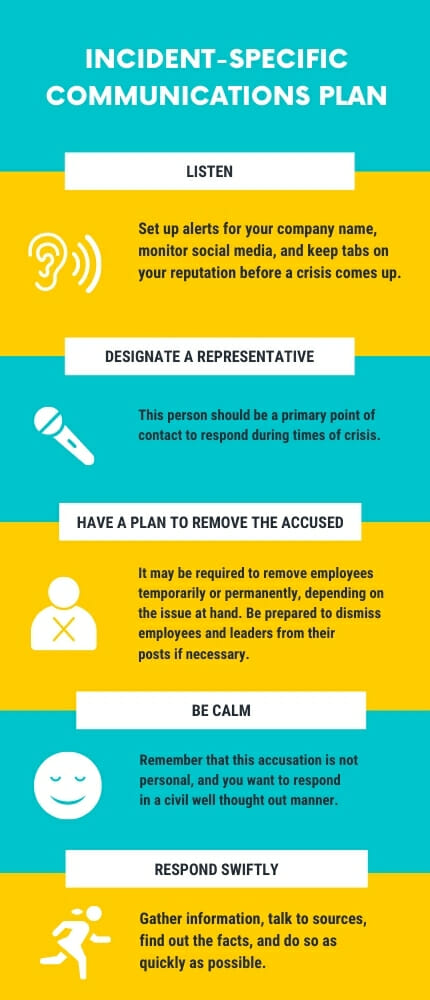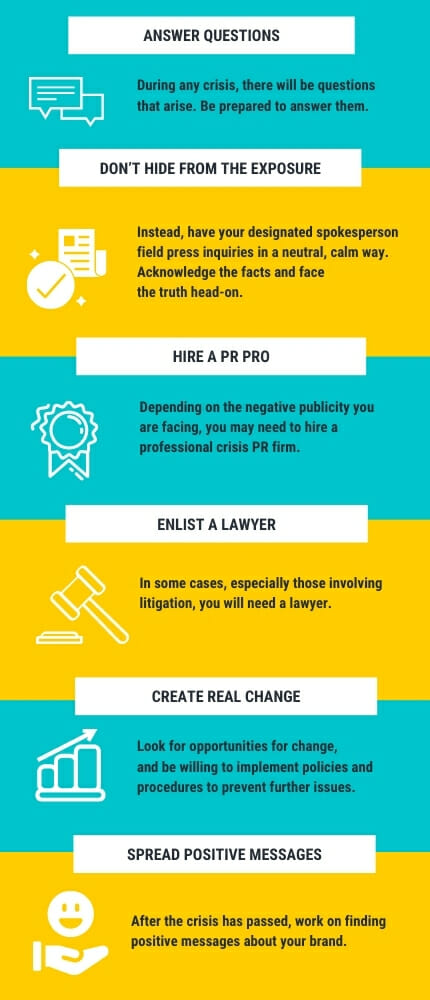Develop a plan to address negative publicity
Employment law violations can result in lawsuits, but that isn’t the only kind of negative fallout. Employers increasingly find themselves in the crosshairs of advocacy groups and media outlets eager to expose perceived wrongdoing.
Additionally, social media allows any employee with a grievance to announce it to the world – and often, these claims gain traction and can go viral. Among recent targets: employers with #MeToo harassment problems and companies whose owners have unpopular political leanings.
It can take years to develop a positive brand reputation, and a positive reputation and brand sentiment has real implications for the bottom line of a business. No company is immune to bad publicity – and smart employers make plans to react to negative publicity before it happens.
The key to addressing negative publicity is to be proactive and ready to tackle any crisis head-on.
Case in point
When The Nation, a left-leaning magazine, first interviewed women who worked at McDonald’s restaurants, it heard tales of sexual harassment.
Deploying a team of investigative reporters and pollsters, the publication surveyed 782 current and former female hourly McDonald’s employees. After reviewing the results, 75% of them reported on-the-job sexual harassment. While only 20% said neither they nor their co-workers had been harassed.
The resulting magazine story, published in late May, generated an outpouring of attention from other news media. McDonald’s responded to the allegations by asserting that the survey pool represented a tiny fraction of the company’s 800,000 U.S. employees.
Prepare to respond to negative publicity
Despite facing a $500 million class-action lawsuit, McDonald’s likely prevented lasting damage by addressing the issue head-on. The company has implemented a “safe and respectful” workplace training for all corporate-owned stores. In addition, they have instituted updated policies and a hotline that employees can use to report concerns.
As an employer, do all you can to eliminate harassment and discrimination. Nevertheless, assume you won’t prevent all poor behavior and that the truth of any misconduct will come out.
Your organization should prepare to address any allegations head-on.
Negative company publicity plan
The first step in addressing negative company publicity should take place before an incident ever occurs. You want to start by developing a negative company publicity plan. This plan should include the following:
- Who needs to be contacted when a crisis happens? Often this consists of the press contact, CEO, HR, and other essential members of the business leadership team. Ensure an up-to-date list of everyone who should be contacted is maintained and includes both their business and personal phone numbers.
- What needs to be done to mitigate the negative publicity? Think about potential risks and develop draft contingency plans for them before a crisis happens. Create media holding statements to address the top threats.
- Develop a response matrix so that the company is prepared to respond appropriately to specific events. A sexual misconduct claim will require a different response than a customer complaint.
 Incident-specific communications plan
Incident-specific communications plan
Once your basic response plan is ready, prepare an incident-specific communications plan that includes these elements:
- Listen. Set up alerts for your company name, monitor social media, and keep tabs on your reputation before a crisis comes up. In this way, you can determine if you have one disgruntled customer or employee or if there is a real issue at hand that needs to be addressed.
- Designate a representative. This person should be a primary point of contact to respond during times of crisis. Your spokesperson should be readily available to directly address the press along with handling incoming inquiries and issuing official company statements. Often this is a trained press representative, but it could also be the company CEO or another leader. Also, you need a plan to have someone respond to social media posts that paint your company in a bad light. It is essential to monitor social media and address concerns as they arise. Having a matrix that defines what type of requests need a response can be helpful and ensures consistency – not everything will require a reply.
- Have a plan to remove employees accused of misbehavior. It may be required to remove employees temporarily or permanently, depending on the issue at hand. Be prepared to dismiss employees and leaders from their posts if necessary. Executive leaders and board members should agree to such step-down plans in advance—even if they are implicated in the crisis.
- Be calm. Remember that this accusation is not personal, and you want to respond in a civil well thought out manner. Reacting with anger or impatience can make an already stressful situation much worse. Do not go to social media and blast users – it will only lead to a war that you can’t win.
- Respond swiftly. Gather information, talk to sources, find out the facts, and do so as quickly as possible. Create a holding statement to manage media inquiries that come in while conducting the initial investigation. If the situation arises on social media, respond if you must, but try to take the conversation to direct messaging or schedule a phone call.

- Answer questions. During any crisis, there will be questions that arise. Be prepared to answer them. You can draft sample questions that may come up when you are creating your negative publicity plan.
- Don’t hide from the exposure. Instead, have your designated spokesperson field press inquiries in a neutral, calm way. Acknowledge the facts and face the truth head-on. People do not respect employers that appear to be dodging negative attention.
- Hire a PR pro. Depending on the negative publicity you are facing, you may need to hire a professional crisis PR firm. These organizations are familiar with mitigating issues and helping businesses overcome negative publicity. They can help you navigate the unknown waters and craft the right messaging to overcome the crisis.
- Enlist a lawyer. In some cases, especially those involving litigation, you will need a lawyer. Together, the PR and litigation teams should develop responses to media and shape the coverage of any lawsuits and their outcomes.
- Create real change. Look for opportunities for change, and be willing to implement policies and procedures to prevent further issues. Various companies, from Volkswagen to Boeing, have faced PR disasters and have had to face public scrutiny and substantial financial losses because of them. While Boeing still has 737 MAX jetliners grounded due to multiple crashes, Volkswagen was very open with its admission of wrongdoing. It mounted an expensive campaign to rectify the emissions issues with its diesel vehicles. Years later, Volkswagen is still recovering from the brand damage done.
- Spread positive messages. After the crisis has passed, work on finding positive messages about your brand. By making real changes and then highlighting them, you can help show that you have grown from the situation and boost positive sentiment again.
Typically, companies with a reputation for ethical and robust values weather the storms of lousy publicity better than others. The best way to prevent unfavorable publicity is to confirm that your company has robust policies and procedures in place to prevent misconduct.
Leaders should set the example by following the code of conduct and living the company values for all employees to see. Ensuring that you have strong anti-harassment and anti-discrimination policies and a supportive company culture can go a long way to avoiding many issues.
In addition, sensitivity training, diversity training, and communications training can arm managers and employees with the knowledge they need to help prevent and detect incidents.







